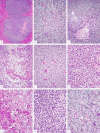Sarcomas With CIC-rearrangements Are a Distinct Pathologic Entity With Aggressive Outcome: A Clinicopathologic and Molecular Study of 115 Cases
- PMID: 28346326
- PMCID: PMC5468475
- DOI: 10.1097/PAS.0000000000000846
Sarcomas With CIC-rearrangements Are a Distinct Pathologic Entity With Aggressive Outcome: A Clinicopathologic and Molecular Study of 115 Cases
Abstract
CIC-DUX4 gene fusion, resulting from either a t(4;19) or t(10;19) translocation, is the most common genetic abnormality detected in EWSR1-negative small blue round cell tumors. Following their discovery it was debated if these tumors should be classified as variants of Ewing sarcoma (ie, atypical Ewing sarcoma) or as a stand-alone pathologic entity. As such the WHO classification temporarily grouped the CIC-rearranged tumors under undifferentiated sarcomas with round cell phenotype, until further clinical evidence was available. However, most studies reported so far include small series with limited follow-up information, which preclude a more definitive assessment. The present work investigates the clinicopathologic features of a large cohort of sarcomas with CIC gene rearrangement, to define their clinical presentation, morphologic spectrum, and outcome. Our study further examines the overall survival of the CIC-positive cohort compared with a control group of EWSR1-rearranged Ewing sarcoma matched for age and stage. The study cohort included 115 patients, with a mean age of 32 years and a slight male predominance. Most tumors occurred in the soft tissue (86%), predominantly deep-seated and equally divided among trunk and extremity, followed by visceral locations (12%) and rarely in the bone (3%). Microscopically, most tumors showed round to ovoid cytomorphology but half of the cases showed also focal areas of spindling and epithelioid/rhabdoid phenotype, with frequent myxoid stromal changes. Variable CD99 reactivity was seen in 84% cases, with a diffuse pattern only in 23% of cases, whereas nuclear WT1 was seen in 92%. A CIC-DUX4 fusion was detected in 57% of cases, with either DUX4 on 4q35 (35%) or on 10q26 in 25 (22%) cases. No FOXO4 gene rearrangements were present in 39 cases tested. Clinical follow-up was available in 57 patients, with a 5-year survival of 43%, which was significantly lower than the 77% 5-year survival in the control Ewing sarcoma group (P=0.002). Our findings show that CIC-DUX4 sarcomas occur most commonly in young adults within the somatic soft tissues, having a wide spectrum of morphology including round, epithelioid and spindle cells, and associated with an aggressive clinical course, with an inferior overall survival compared with Ewing sarcoma. The results support the classification of CIC-rearranged tumors as an independent molecular and clinical subset of small blue round cell tumors distinct from Ewing sarcoma.
Conflict of interest statement
Figures



References
-
- Fletcher C, Bridge JA, Hogendoorn PC, et al. WHO Classification of Tumours of Soft Tissue and Bone. IARC; Lyon: 2013.
-
- Delattre O, Zucman J, Plougastel B, et al. Gene fusion with an ETS DNA-binding domain caused by chromosome translocation in human tumours. Nature. 1992;359:162–165. - PubMed
-
- Sorensen PH, Lessnick SL, Lopez-Terrada D, et al. A second Ewing’s sarcoma translocation, t(21;22), fuses the EWS gene to another ETS-family transcription factor, ERG. Nat Genet. 1994;6:146–151. - PubMed
-
- Kawamura-Saito M, Yamazaki Y, Kaneko K, et al. Fusion between CIC and DUX4 up-regulates PEA3 family genes in Ewing-like sarcomas with t(4;19)(q35;q13) translocation. Hum Mol Genet. 2006;15:2125–2137. - PubMed
MeSH terms
Substances
Grants and funding
LinkOut - more resources
Full Text Sources
Other Literature Sources
Medical
Research Materials
Miscellaneous

